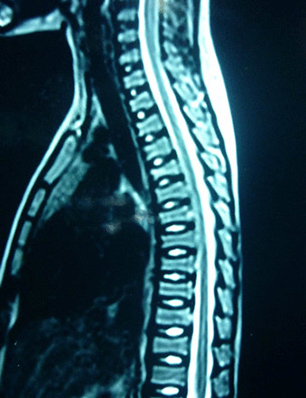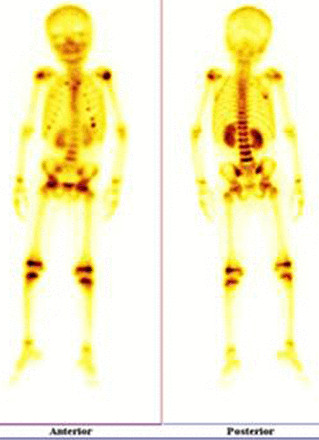Etiology
Humoral hypercalcemia of malignancy is most commonly associated with:[1][2][10]
Renal cancer
Ovarian cancer
Breast cancer
Endometrial cancer
Human T-lymphotropic virus-associated lymphoma
Squamous cell carcinoma.
Local osteolytic hypercalcemia is most commonly associated with:[1][10]
Breast cancer
Multiple myeloma.
Calcitriol (1,25-dihydroxyvitamin D)-mediated hypercalcemia is associated with:[1][10]
Lymphomas (of all types)
Granulomatous disease (such as active sarcoidosis) or tuberculosis.
Ectopic parathyroid hormone secretion by tumors is rare, but has been reported.[1][11][12]
Pathophysiology
Humoral hypercalcemia of malignancy: tumor secretion of parathyroid hormone-related peptide (PTHrP) leads to activation of osteoclastic bone resorption and suppression of osteoblastic bone formation. This results in skeletal release of calcium and subsequent hypercalcemia. PTHrP also acts at the level of the kidney to reduce calcium clearance, as well as to reduce the renal phosphorus threshold, leading to hyperphosphaturia and hypophosphatemia.[1][2]
Local osteolytic hypercalcemia: in the setting of malignancy with widespread skeletal involvement, local release of cytokines (e.g., interleukin [IL]-1 and IL-6), chemokines, and PTHrP leads to increased osteoclastic bone resorption, and to increased release of calcium into the serum that overwhelms the kidney's capacity to clear calcium.[5][Figure caption and citation for the preceding image starts]: CT chest showing compression fracture of multiple vertebral bodies in a child presenting with acute lymphoblastic leukemia. Biochemistry showed hypercalcemia with a suppressed parathyroid hormone levelSukumar SP, Balachandran K, Sahoo JP, et al. Acute lymphocytic leukaemia presenting as a metabolic bone disease. BMJ Case Reports 2013; doi:10.1136/bcr-2013-008758 [Citation ends]. [Figure caption and citation for the preceding image starts]: Whole body planar images suggestive of skeletal infiltration in a child with acute lymphoblastic leukemia showing areas of abnormal increased uptake. Biochemistry showed hypercalcemia with a suppressed parathyroid hormone levelSukumar SP, Balachandran K, Sahoo JP, et al. Acute lymphocytic leukaemia presenting as a metabolic bone disease. BMJ Case Reports 2013; doi:10.1136/bcr-2013-008758 [Citation ends].
[Figure caption and citation for the preceding image starts]: Whole body planar images suggestive of skeletal infiltration in a child with acute lymphoblastic leukemia showing areas of abnormal increased uptake. Biochemistry showed hypercalcemia with a suppressed parathyroid hormone levelSukumar SP, Balachandran K, Sahoo JP, et al. Acute lymphocytic leukaemia presenting as a metabolic bone disease. BMJ Case Reports 2013; doi:10.1136/bcr-2013-008758 [Citation ends].
Calcitriol (1,25-dihydroxyvitamin D)-mediated hypercalcemia: overexpression of 1-alpha hydroxylase (the enzyme that converts precursor 25-hydroxyvitamin D [25OHD] to calcitriol [(1,25-dihydroxyvitamin D)]) by malignant or adjacent normal cells leads to autonomous production of bioactive vitamin D.[1][5] Calcitriol (1,25-dihydroxyvitamin D) in turn increases intestinal calcium absorption and subsequent hypercalcemia. In addition, calcitriol (1,25-dihydroxyvitamin D) may stimulate osteoclast-mediated bone resorption.[5]
Ectopic secretion of authentic parathyroid hormone with subsequent hypercalcemia has been rarely reported.[1][11][12]
Classification
Severity
While there is no universally accepted classification of mild, moderate, or severe hypercalcemia, the following criteria are widely used:[6][7][8]
Mild hypercalcemia: total calcium of less than 12 mg/dL (<3 mmol/L) or ionized calcium of 5.6 to 8.0 mg/dL (1.4 to 2.0 mmol/L)
Moderate hypercalcemia: total calcium of 12.0 to 13.9 mg/dL (3.0 to 3.5 mmol/L) or ionized calcium of 10 mg/dL or greater (≥2.5 mmol/L)
Severe hypercalcemia: 14 mg/dL or greater (≥3.5 mmol/L) or ionized calcium of 10 to 12 mg/dL (2.5 to 3.0 mmol/L).
The National Cancer Institute's Common Terminology Criteria for Adverse Events (CTCAE) classifies hypercalcemia of malignancy into four grades premised on corrected serum calcium:[9]
Grade 1: corrected serum calcium (SCa) of >upper limit of normal* to 11.5 mg/dL (2.9 mmol/L); ionized calcium >upper limit of normal to 6 mg/dL (1.5 mmol/L)
Grade 2: corrected SCa of >11.5 to 12.5 mg/dL (2.9 to 3.1 mmol/L); ionized calcium >6.0 to 6.4 mg/dL (>1.5 to 1.6 mmol/L); symptomatic
Grade 3: corrected SCa of >12.5 to 13.5 mg/dL (3.1 to 3.4 mmol/L); ionized calcium >6.4 to 7.2 mg/dL (>1.6 to 1.8 mmol/L); hospitalization indicated
Grade 4: corrected SCa of >13.5 mg/dL (>3.4 mmol/L); ionized calcium >7.2 mg/dL (>1.8 mmol/L); life-threatening consequences.
*upper limit of normal: serum calcium 10.8 mg/dL (2.7 mmol/L); ionized calcium 5.3 mg/dL (1.3 mmol/L) (values may vary among laboratories)
Causes of hypercalcemia of malignancy
Humoral hypercalcemia of malignancy is most commonly associated with:[1][10]
Renal cancer
Ovarian cancer
Breast cancer
Endometrial cancer
Human T-lymphotropic virus-associated lymphoma
Squamous cell carcinoma.
Local osteolytic hypercalcemia is most commonly associated with:[1][10]
Breast cancer
Multiple myeloma.
Calcitriol (1,25-dihydroxyvitamin D)-mediated hypercalcemia is associated with:[1][10]
Lymphomas (of all types)
Granulomatous disease (such as active sarcoidosis) or tuberculosis.
Ectopic parathyroid hormone secretion by tumors is rare, but has been reported.[1][11][12]
Use of this content is subject to our disclaimer